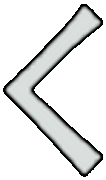| |
Kenaz
|

Elder Futhark

Anglo Saxon |
Pronunciation: kane-awez
Literal Meaning: Torch; later ulcer, disease, sickness
Other Names: Kaunan , Ken, Kuan, Cén
Phonetic Value: K and C
|
| Rune Poems |
| Anglo Saxon |
Cén byþ cwicera gehwam, cuþ on fyre blac ond beorhtlic, byrneþ oftust ðær hi æþelingas inne restaþ. |
| Cén is for the living known by its fire, flashing bright it burns, often where princes rest within. |
| |
| Norwegian |
Kaun er barna bo,lvan; bo,l gørver nán fo,lvan. |
| Kaun is fatal to children; death makes a corpse pale. |
| |
| Icelandic |
Kaun er barna böl ok bardaga för ok holdfúa hús. flagella konungr. |
| Kuan is the bane of child hood, the yoke of battle, who’s home is the flesh. King of Whips |
|
This is the rune of light and illumination, according to the oldest of these poems. Due to linguistic shifts change the name from kenaz to kaunan, which means ulcer or disease.
|
A word on translation:
The last line of the Icelandic Poem is also a false cognate due to parallel entomological evolution. Flagella konungr literally translated from modern islandic the phrase is “King Flagella”. This appears to indicate a king of bacteria or disease, however this use of flagella has only been in use for a couple of centuries. It shares its root with the Latin flagellum meaning "whip, scourge". A more proper translation might be “king of lashes”, a possible reference to the redness of skin while sick that sounds suspiciously like flagellate erythema.
|
|
|
|
|